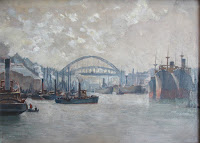Overview
The University Art Collection at the University of Hull, is a relatively small, but focussed collection devoted to British Art between 1890 and 1940.
The collection includes works by some of the "big names" of this period.
It is well thought out and presented.
First Gallery, with Frank Dobson's Cornucopia, 1925-27, in the foreground
History
The collection was only inaugurated in 1963 and had limited resources. This meant that the university concentrated on the less fashionable schools of the time. Malcolm Easton, founder curator, wrote in 1965:
"We believe that the choice, in terms both artistic and educational, has spendidly justified itself.....The country cannot fail to be impressed by the quality of our acquisitions and the enlightened generosity of our patrons..."
(Leaflet, University Art Collection, Art in Britain 1890-1940, University of Hull)
The collection supports the studies of university students in the history of art, research and art appreciation, and that of the wider community as it is open to members of the public.
The Collection
The Collection is housed in a new gallery, which forms part of the Brynmor Jones Library. It is well laid out with good lighting. The University provides a helpful leaflet which sets out a floor plan as to the layout of the exhibits and key artists (see below).
 |
| Floor Plan |
The first impression if of a light and airy environment. The works follow a datal sequence, with some specialist areas, such as for portraiture and draughtsmanship. There is an area set aside for temporary displays and scattered throughout the galleries are sculptures by eminent artists of the period.
I have selected below some examples of the works on display from photographs I took on my visit. I have concentrated on landscapes and, in particular, my theme of how human activity relates to and interacts with the natural landscape.
Walter Richard Sickert, L'Eglise du Pollet, Dieppe, c. 1900
Sickert was perhaps the leading British Impressionist. He was a pupil of Whistler and influenced by Degas. In 1911 he co-founded the Camden Town Group.
Roger Fry, Farm Buildings, France, c. 1913
Fry was both a painter and an influential art critic. He was Director of the Metropolitan Museum, New York and editor of the Burlington magazine. He was deeply impressed by Cezanne and organised the two Post-Impressionist Exhibitions in London, becoming the leading champion of modern French art in Britain.
Stephen Bone, Swing Bridge, High Level Bridge and King Edward VII Railway Bridge, Newcastle upon Tyne, late 1920s
Clifford Hall, A Street in Malakoff, 1928
Charles Cundall, The Wear Bridge c. 1930
John Piper, Great Goxhill, Lincolnshire, 1947
This work is a good example of Piper's atmospheric style and art of the "New Romanticism" of the mid-1930s
Charles Ginner, Wear Cliffs, Dorset, 1922
Augustus Lunn, Lowestoft, 1938, watercolour
James Dickson Innes, Sunset in the Pyrenees, c. 1912-13
Colour
Lucien Pissarro, Blossom, Sun and Mist: Chipperfield, 1914
Lucien was the eldest son of the French Impressionist painter, Camille Pissarro. he studied under his father and was influenced by Seurat. Note the muted colour palette.
Samuel John Peploe, Interior with Japanese Fan, c. 1915
Peploe studied in Edinburgh and Paris. He was one of a group of Fauve-influenced Scottish artists now known as the "Scottish Colourists". The bright, contrasting colours are typical of this group of painters.
Curation
Above: Example of the curation of the collection: Sir Stanley Spencer's Villagers and Saints of 1933 on the rear wall and Henry Moore's Family Group, 1945 to the left.
I was fortunate in being able to meet John Bernasconi, Director of the University Art Collection, who lectures in art history. He specialises in Italian Renaissance art and art in Britain, 1890-1940. He organises an annual programme of exhibitions and public lectures for the university. Bernasconi emphasised the importance of specific artists and movements of the period included in the university's collection. He explained the layout of the galleries and the thinking behind the scheme. The paintings are hung mainly in chronological order, but with areas covering particular schools or key themes. Big names such as Epstein, Bomberg, Vanessa Bell, and Augustus John feature, and each exhibit is accompanied by a short resume of the artist's background, career, influences and importance. To illustrate the importance of curation, he told me how he gave an important, highly original work by Sir Stanley Spencer prominence, by hanging it in the middle of the wall at the end of the run of galleries to each side. The university is lucky to have such works included in its collection.
Summary and conclusions
The visit was informative from the point of view of seeing further examples of high quality landscapes from prominent British artists. There were a number of industrial scenes. The period covered was limited and the styles reflected the era. This was not a disadvantage and it gave me much food for thought. Some of the industrial scenes were very impressive and displayed a reduced palette dominated by greys which I was interested in. Pissarro's cool colours, mainly greens, also suited his subject matter. In contrast, the work by the Scottish Colourist, Peploe, demonstrated how to use bright, contrasting colours favoured by the Post-Impressionist Fauves, or "Wild Beasts". Overall, I gained a lot of knowledge about the period from my visit and some thought provoking ideas about curation from John Bernasconi.













No comments:
Post a Comment